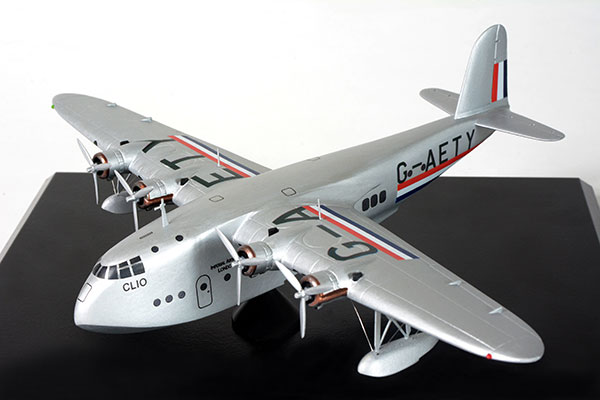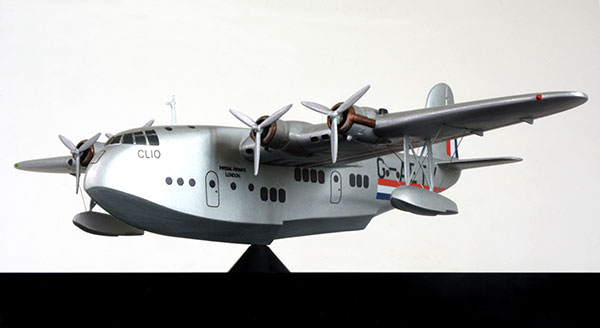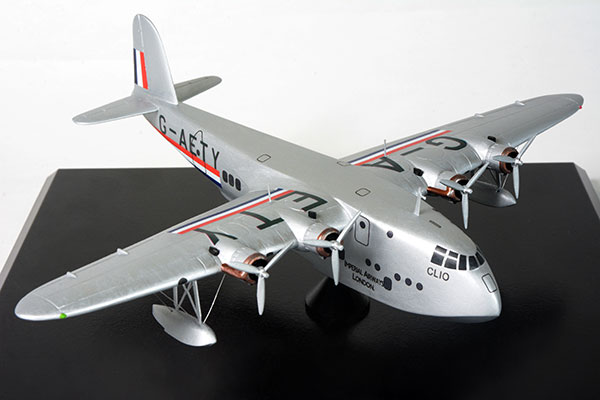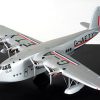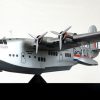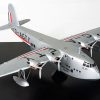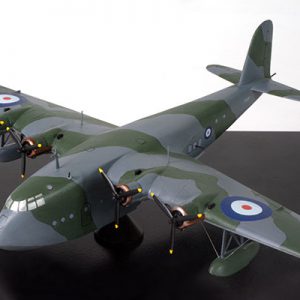Short S.23 ‘C-Class’ Empire Flying Boat
Imperial Airways London G-AETY ‘CLIO’
Late 1939
Few aircraft can capture the spirit of the ‘Golden Age of Flight’ like the empire flying boats of the late 1930s. They were built as a result of the British government stating that from early 1937 all letters dispatched from the UK to the Empire should be delivered wherever possible without surcharge. To meet the target of 2,000 tons of mail per year and to make the enterprise profitable Imperial Airways approached Short Brothers to design a new flying boat. 14 were ordered without delay, this was quickly increased to 28 aircraft.
The new Short S.23 flying boats were given the title ‘C-Class’ and all were given names beginning with the letter C. Powered by four nine cylinder Bristol Pegasus XC radial engines the S.23 was originally configured to carry 24 passengers and 3000 lbs of mail. Later the mail load was increased by 1000lbs and the passengers reduced to 17. A seaplane base at Hythe was built specifically for the C-Class flying boats to operate from as a global base. The Empire Air Mail Service (EAMS) could now be established.
The first S.23 ‘CANOPUS’ made its maiden flight on July 4th 1936 with the first mail flights taking place on the 29th of June 1937 when G-ADVE ‘CENTURION’ took off with 3500lbs of mail for Sudan and East and South Africa. By the start of 1938 S.23s were flying to Palestine, Burma, Ceylon, and Malaya. By the beginning of July that year this was extended to Australia, New Zealand and Western Samoa. C-Class flying boats carried their passengers in the luxury of the day and served a full menu for breakfast lunch and dinner. Playing cards, crosswords, jigsaw puzzles, books, children’s magazines, games and sunglasses were also available in flight.
Extending the range of the C-Class between refueling stops was always on the cards, initially with additional fuel tanks, but later with in-flight refueling. The C-Class G-AFCU ‘CABOT’ was such a long range aircraft. Named after Sebastian Cabot (c1476-1557) explorer, associated with Bristol, voyages across the Atlantic and the discovery of Newfoundland. G-AFCU ‘CABOT’ was built with extra fuel tanks and like her sister aircraft ‘CARIBOU’ in-flight refueling. These two aircraft were built for the Trans-Atlantic mail route and designated S.30. The in-flight refueling technique can best be described as hazardous. Taking off as usual from Hythe ‘CABOT’ would rendezvous with the tanker, a Handley Page Harrow (J9833 prototype) off Ireland. A rocket with cord attached was fired by a crewmember on the S.30 to capture the trailing tanker fuel hose. The hose was connected manually to a receptical in the tailcone and the fuel would transfer by gravity to ‘CABOT’. Surprisingly this method, although frought with danger, worked successfully.
The twentieth C-Class was G-AETY ‘CLIO’ which was ordered on 2nd September 1935 and delivered on the 30th of July 1937. Clio was one of the nine Muses, the Proclaimer, the aircraft badge shows Clio declaiming from a scroll. With the outbreak of war in September 1939 it was decided that civil aircraft should wear distinguishing markings to identify them as non-combat aircraft. To this end red white and blue flashes were added beneath the civil registration markings. A tail flash was often added but varied in style. The capabilities of the C-Class were not missed by the RAF who required a long range marine reconnaissance patrol aircraft and the S.23 was ideally suited to this role. The first two long range C-Class commandeered by the RAF were destroyed by the Luftwaffe in Norway, subsequently two more S.23’s were requisitioned before Short Brothers completed development the legendary Sunderland to fulfil the RAF’s requirements.


